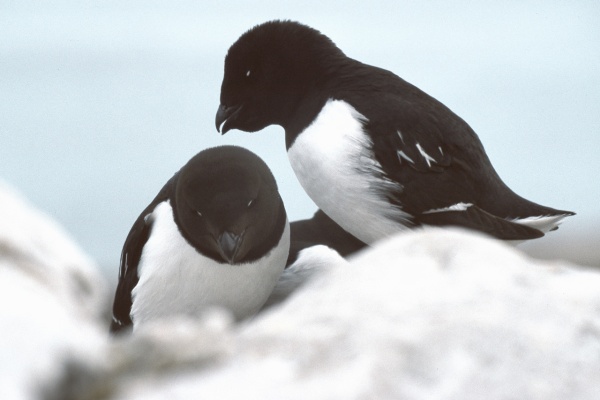Yesterday I wrote about copepods and polynyas so I could introduce this bird, the dovekie.
Though I visit Maine every September and even take pelagic trips in the Gulf of Maine, I have never seen a dovekie. That’s because they breed on islands in the High Arctic (Baffin Island, Greenland, Iceland, etc) and don’t leave their breeding grounds until late August. At that point they’re molting and flightless so they drift on the southbound current to spend the winter in the North Atlantic. They usually aren’t seen off the coast of Maine until November.
Dovekies (Alle alle), also called little auks, are cute little seabirds about the size of a starling but much fatter — two to three times the weight of a starling. They are so numerous that there are tens of millions of them in the North Atlantic in winter.
The two shown above are in breeding plumage at Svalbard. Their eyes are black but look white in this photo because they’re half closed. Perhaps they’re whispering sweet nothings to each other.
In the U.S. we only see dovekies in winter plumage. Here’s a video of one off the coast of North Carolina in January that gives you a sense of how tiny these birds are.
In the breeding season dovekies depend on cold water and ice. Copepods are their favorite food — sometimes their only food — so they locate their breeding colonies near polynyas where copepods are plentiful. In a curious way they’re an edge species, preferring the fertile edge where ice meets open water.
Dovekies are so numerous that you’d think that nothing could threaten their survival. Unfortunately they are easy to hunt at their breeding colonies and global climate change may lower their breeding success.
But who knows? Maybe The Big Melt will help dovekies for a while.
(photo by Michael Haferkamp on Wikimedia Commons. Click on the image to see the original)

Well, I was close with auk 🙂 I’ve never heard of a dovekie. Very cool!
I saw a dovekie up close from the shore last year and was able to observe it for at least an hour. I feel so lucky for the experience. It was definitely one of many favorite birding moments ever. I saw it at the Belmar Inlet in NJ. One of the best parts is that a non-birder tipped me off. He walked up to me because he saw that I had binoculars and said that he saw a penguin-like bird on shore and that it was so small he swore it had to be a chick. He was excited and wasn’t even a birder. I was intrigued. Could it be a dovekie? I put some extra effort into relocating the bird and sure enough I hit the jackpot. I found it, a dovekie, no question about it. It was extremely close to shore, diving and paddling. At one point it even climbed up onto a rock a few yards away only to be spooked back into the water by a flyover gull. And the best part is that it did not appear to be injured.
I read two things about the white above the eye which was definitely apparent. One is that the nictitating membrane is covered with white feathers. The other is that the arc above the eye is composed of white feathers. Here are the links.
http://elibrary.unm.edu/sora//Auk/v050n01/p0105-p0105.pdf
http://www.wildmagazine.com/facts/Dovekie.asp?page=/facts/Dovekie.asp
Sorry. I love dovekies. Here’s my favorite photo of one.
http://www.flickr.com/photos/nigelblake/2370111540/
No need to apologize. They are VERY cute.
I grew up in northern Maine, 200 miles from the ocean, and we occasionally had them blown in during storms. One of my favorite family photos, dated May, 1964, is a picture of my brother holding a Dovekie in his hands. Unfortunately they do not often make it unless someone takes it to open water.
Kate – My friends found a dovekie about 2 miles inland in a farm field yesterday (12/27) after the storm passed by. The winds had been horrendously strong overnight. An ornithologist friend of mine was able to determine that though the bird did have a leg injury, the injury appeared to be an old one that the bird had been coping with for some time. So, they released the bird into an estuary close to the ocean and it paddled away. I did not get to see or handle the bird as I was working, but my ornithologist friend (who has been a serious birder for probably 2 decades and never seen a dovekie) said that the feathers were so dense that they felt more like fur. He also remarked that the bird fit neatly into the palm of his hand.